|
UNITED STATES |
|
SECURITIES AND EXCHANGE COMMISSION |
|
Washington, D.C. 20549 |
|
|
|
FORM N-CSR |
|
CERTIFIED SHAREHOLDER REPORT OF REGISTERED |
|
MANAGEMENT INVESTMENT COMPANIES |
|
|
|
Investment Company Act File Number: 811-5833 |
|
T. Rowe
Price Institutional International Funds, Inc. |
|
(Exact name of registrant as specified in charter) |
|
100 East Pratt Street,
Baltimore, MD 21202 |
|
(Address of
principal executive offices) |
|
David Oestreicher |
|
100 East Pratt Street,
Baltimore, MD 21202 |
|
(Name and
address of agent for service) |
|
Registrant’s telephone number, including area code: (410) 345-2000 |
| Date of fiscal year end: October 31 |
| Date of reporting period: April 30, 2010 |
Item 1: Report to Shareholders
 |
| Institutional International Growth Equity Fund | April 30, 2010 |
(Formerly the Institutional Foreign Equity Fund)
| Highlights |
• International stock markets posted solid gains in the six-month period ended April 30, 2010, continuing the rally that began more than a year ago.
• The fund outperformed its benchmark index and Lipper peer group average in the first half of its fiscal year, led by strong gains in consumer and information technology holdings.
• Our investment focus remains on companies with durable global franchises that can grow their earnings and cash flow at a double-digit rate over the long term.
• Our research is uncovering attractive growth opportunities across a broad array of international stock markets, and we remain especially encouraged by the prospects for emerging markets.
The views and opinions in this report were current as of April 30, 2010. They are not guarantees of performance or investment results and should not be taken as investment advice. Investment decisions reflect a variety of factors, and the managers reserve the right to change their views about individual stocks, sectors, and the markets at any time. As a result, the views expressed should not be relied upon as a forecast of the fund’s future investment intent. The report is certified under the Sarbanes-Oxley Act, which requires mutual funds and other public companies to affirm that, to the best of their knowledge, the information in their financial reports is fairly and accurately stated in all material respects.
Manager’s Letter
T. Rowe Price Institutional International Growth Equity Fund
Dear Investor
We are pleased to report good results for the six months ended April 30, 2010. Although the fund’s name has changed, our disciplined investment approach remains the same. The fund’s solid returns were in large part due to our talented research team and our conviction in our analysts’ best ideas. We believe emerging economies offer strong growth prospects over the intermediate and longer term and that gains across mature markets are likely to be lower than those posted in recent quarters. The portfolio remains broadly diversified across regions, countries, and sectors and focused on companies with the best long-term growth prospects.
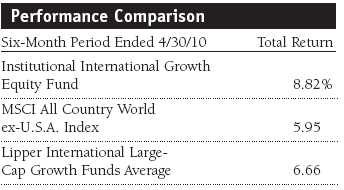
The Institutional International Growth Equity Fund earned 8.82% for the six-month period ended April 30, 2010. As shown in the Performance Comparison table, the fund outperformed the benchmark MSCI All Country World ex-U.S.A. Index. The fund’s strong relative performance benefited from stock selection, especially in the consumer discretionary, health care, information technology, and telecommunication services sectors. In a reversal from the prior six months, financials posted losses during this reporting period and were the largest detractors in our comparison with the MSCI benchmark. In general, the portfolio’s emerging markets holdings were good contributors, benefiting from stock selection in China and Brazil.
Portfolio Strategy
Through the market malaise in 2008 and the subsequent rally in 2009, we did not waiver from our core investment philosophy—buying high-quality growth companies that have a competitive advantage in their respective markets. Since the bear market low in early 2009, the portfolio has delivered unusually strong results. The fund focuses on long-term performance and eschews fad investments and momentum trading. We believe that over the long term, stock prices move with earnings and cash flow growth, meaning simply that if a company grows free cash flow by 15% a year, its stock should appreciate at roughly the same rate. We search for companies we think can generate double-digit earnings growth over time by participating in expanding markets, taking market share, or improving profitability faster than sales. We think that if we can find those companies and pay a fair price for their stock, we can compound absolute returns at double-digit levels and provide solid long-term relative returns.
With this objective in mind, our industry analysts, as well as other T. Rowe Price portfolio managers, attempt to find companies that fit these criteria. We look for the best stocks wherever we may find them rather than employing a regional, country, or sector focus. While we are mindful of the broad economic conditions in regions and countries, the portfolio’s composition is primarily determined by individual stock considerations.
Market Review
I am both amazed and embarrassed by the market’s short-term fickleness. Amazed because the stock market is supposed to price companies based on the discounted value of the long-term cash flow that they generate, and near-term headwinds do not change that value a great deal. At the same time, I’m embarrassed because as professionals, we know this, and yet many still choose to make a roller coaster ride out of the gradual hills and valleys that make up the everyday economic landscape. I am in no way insinuating that the issues that the market faced at the end of 2008 were not an economic cliff, but market participants seem to be magnifying the slope of every expected change in the terrain.
Sentiment about stocks, sectors, and countries now seems to vacillate between extremes in the blink of an eye. In recent months, we’ve gone from Japan is a mess to Europe is a mess to what a wonderful job Japan has done with cutting costs. We’ve seen all commodities viewed as if they were gold because China is a great long-term growth story to all commodities will crash as China taps on the brakes to slow its surging economic growth. We heard that the U.S. consumer was dead, and then almost in the next breath investors are asking how to best leverage their bet on the U.S. consumer recovery.
Through the chaos that includes day-to-day predictions of economic tsunamis, volcanic ash-laden storm clouds rolling in over Europe, and raging bull market rebounds, we attempt to discern the intermediate- and longer-term trends and find opportunities within what appears to be a bipolar marketplace. While we are frustrated by this fickleness, we will try to exploit the market’s shortsightedness to reward our shareholders with long-term gains.
At this time, our investment decisions are being shaped by the following views:
• Economies and earnings are improving in most regions.
• Interest rates have remained low in mature markets but are rising in developing markets, which could prove to be a near-term headwind for emerging countries.
• Consumer spending in emerging markets should continue to be a strong global growth driver.
• The turmoil in Greece and the resultant contagion in Europe may not be resolved quickly and could slow growth for companies that operate in the region.
• Financials, especially in the banking segment, are likely to face higher capital requirements, which will undoubtedly mean more regulation and lower return on equity.
• Government policy decisions are increasingly affecting our investment decisions.
Portfolio Positioning
As bottom-up stock pickers, we analyze every company for several criteria. First, we determine the quality of its management, its growth potential, its fundamental merits, and its ability to generate cash flow over time. We attempt to discern if the management team is effective in deploying its free cash flow. We also look to see if the company is taking market share and whether it has pricing power. Next, we analyze whether the stock, at current prices, offers a good risk/reward proposition over the next few years. Additionally, we are increasingly assessing how government policy will impact companies in various regions and sectors. Balancing the answers to these questions shapes our buying and selling decisions and, ultimately, the size of the positions in the portfolio.

In recent months, we have become more concerned about governments that take anti-business actions that hurt corporate profits. We think that government policy is becoming a bigger part of the investment equation. Markets go through periods where there is more and then less interference from governments. We believe that we are entering a period where governments will have a greater influence on corporations’ revenues and earnings.
We think regulators in Europe will decide
to raise capital requirements across the banking system, which, in turn, would crimp profits in the financials sector. We think that China’s decision to slow its rate of economic growth will hurt commodity prices in the short term. OPEC’s
decisions and legislation that affects drilling rights following the recent oil spill in the Gulf of Mexico will clearly affect the energy sector. The Australian government recently announced a new tax on mining company profits, and, at home, the
U.S. government has enacted a sweeping health care reform plan. We fear that governments may take other actions or implement policies to extract profits from companies and bolster their fiscal positions. These policies and actions are growing in
scope and frequency. They are most prevalent in mature markets and are likely to be detrimental to long-term global economic health.
Portfolio Review
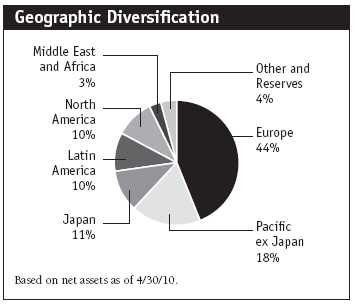
In the April to October period last year, emerging markets were clearly doing best, and in the last six months, the rest of the world’s economies have started getting better. Earnings gains and improvement in economic growth have been reported in virtually all developed and emerging markets over the last six months.
Several emerging markets have had to apply a measure of fiscal restraint to slow overheating economic growth, but we think that higher rates will prove to be just a short-term negative and that developing markets can still generate good long-term growth. Although stocks in Brazil and China hurt our results in the first few months of 2010, we held our favorite holdings and remain overweight in both countries. While this decision may continue to hurt our performance in the coming quarters, we believe that over the longer term both of these large emerging markets can generate above-average growth.
Where We Were Positioned and Why
Your portfolio generated good results in the last six months because of our conviction in our analysts’ best ideas. Our goal is to always improve the quality of the companies that we own, and we remain vigilant in managing risks
relative to the potential return of our holdings. Investing in European countries could remain challenging because governments within the region will need to focus on balance sheet repair at the expense of growing their economies. We were somewhat
underweight in Europe, but it was not because we thought the euro would go lower or its troubles would spread. It was largely because we found more compelling ideas in other regions.
If, as we expect it will, European growth remains under pressure, global inflationary pressures will ease, allowing emerging markets to generate higher sustainable growth. We are always looking for the best growth stocks, but right now our portfolio is tilted somewhat more toward stable companies that pay dividends and can grow earnings at a double-digit pace.
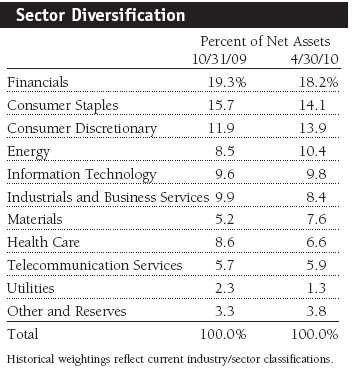
Over the past six months, several of the portfolio’s largest contributors were in the consumer discretionary sector. Media holdings Jupiter Telecommunications (Japan) and Liberty Global (U.S.) generated strong gains due to recent acquisition activity. We tendered about one-third of our Jupiter position to KDDI (the second-largest wireless operator in Japan) at a large premium to the current market price. We still think that Jupiter’s shares are attractively valued and believe that the company can continue to generate good growth. Although Liberty is headquartered in the U.S., it is one of Europe’s largest cable providers. The company also benefited from tendering its entire position in Jupiter to KDDI. Liberty Global has now exited the Japanese market and is entirely focused on the European market, and its operations there appear to be performing well. (Please refer to the portfolio of investments for a complete listing of holdings and the amount each represents in the portfolio.)
Ctrip.com International, a Chinese provider of discount hotel reservations, airline tickets, and package tours, posted good revenues and earnings over the last six months thanks in part to the improving consumer spending environment. Similarly, Switzerland-based Compagnie Financière Richemont, one of the world’s premiere luxury goods companies with brands including Cartier and Van Cleef & Arpels, also surged during the period. Sales of the company’s high-end jewelry, watches, writing instruments, and clothing benefited as stock markets rebounded and sentiment improved about future economic growth.
We added a few companies in the consumer discretionary sector that performed well during the reporting period. In Brazil, we added Lojas Renner, the country’s second-largest retail clothing chain, and PDG Realty, one of its largest real estate companies. We also eliminated several stocks that had reached our target price or no longer fit our growth criteria, including shoe makers Geox and Adidas. Similarly, we closed out our position in Swatch, one of our better-performing holdings during the period, because we thought the shares had become expensive compared with its growth prospects.
Our information technology holdings were the next-best contributors over the past six months. The sector’s returns were led by across-the-board gains in electronic equipment manufacturers. Internet software and services stocks also performed well. We like Internet companies because they have a low fixed-cost base and minimal capital costs, and they typically generate predictable cash flow and little debt. As is the case in the consumer sectors, we are overweight technology compared with the MSCI benchmark.
We like Chinese Internet software and services companies because we believe China will continue to generate durable economic growth. The portfolio benefited from gains in our longtime position in Tencent Holdings, the popular free instant messaging service in China. The company, one of our largest holdings in the tech sector, did not perform well at the end of the reporting period because investors became worried that the gaming part of its business was topping out. We trimmed our position and locked in some profits because we anticipate somewhat slower earnings growth but continue to like the company’s long-term prospects. Other notable contributors in the sector included Japanese holdings Nidec and Nippon Electric Glass, Hon Hai Precision (South Korea), and ASML, a Netherlands-based leader in lithography systems for the semiconductor industry. We also locked in a large profit and closed out our position in Baidu, the leading Chinese Internet search engine.
The portfolio had several top-performing stocks in almost every sector. In consumer staples, retailers Magnit (Russia), Wal-Mart de Mexico, and Jeronimo Martins (Portugal) were strong contributors. Within the industrials sector, DP World, one of our larger holdings, performed especially well. The port operator benefited from the resurgence in shipping. The Dubai-based company’s largest asset is the Dubai Port, which we jokingly refer to as a “monopoly goldmine.” We bought the stock when shipping was in the dumps, and as it came back, the stock has appreciated nicely.
Mobile phone services provider NII Holdings, formerly known as Nextel International, was the portfolio’s best contributor. The company sells phones and wireless service in Latin America and recently signed a joint marketing agreement with Televisa that included a 30% equity stake in the company’s Nextel Mexico operations. Although telecommunication services is one of the smaller sectors in the fund and the benchmark, strong stock selection within the group provided an excellent relative performance contribution.
One of our most promising recent additions in the telecom sector is Softbank. The Japanese company is among the largest Internet-related companies in Asia and has a substantial wireless presence in its homeland. However, the main reason for our investment is that the company is a 33% owner of privately owned Alibaba Group (which is different than Alibaba.com, one of our Chinese Internet holdings). We think that in a year or so, the company will spin off two of its Chinese Internet subsidiaries: Taobao, an e-commerce company, and Alipay, which processes online payment transactions. We believe both of these new issues will be highly valued and could eventually be worth more than half the value of Softbank.
The portfolio’s financials holdings were the worst performers in the past six months. National Bank of Greece and Banco Santander (Spain) were among our largest detractors—these commercial banks had been top contributors in the prior six-month period (April to October 2009). Toward the end of the period, we trimmed both holdings. We also eliminated Grupo Financiero Banorte (Mexico) and Intesa Sanpaolo (Italy). We sold Banorte when we felt it had reached full value. We eliminated Intesa in favor of other companies with better growth prospects in the financials sector. Both stocks generated modest positive returns in the past six months and solid gains while we held them in the portfolio. We moved proceeds from those sales to other banks and insurers where we have more conviction in the growth prospects.
One of our new positions in the sector is Banco Santander Brasil. It is largely owned by its Spain-based parent, but the Brazilian subsidiary does not face the issues associated with Spain, and it is growing much faster. We also added to our position in AXA. Although the France-based insurer was one of the portfolio’s worst performers in the period—investors were concerned about the company’s European bond holdings—we think its business momentum is good and that the company can continue to generate a solid stream of revenues. The stock also trades at a very attractive earnings multiple. About two-thirds of AXA’s earnings are generated from life insurance and annuity products, and most of the remaining income comes from its property/casualty business.
Julius Baer and Credit Suisse were among our largest purchases over the past six months. Both are significant portfolio holdings that suffered steep price declines in the period. In our view, the shares were oversold. We believe that Julius Baer and Credit Suisse are world-class companies that have strong management teams, offer good growth potential in the private banking segment, and can grow their market share and improve profit margins over time.
Investment Outlook
The “European TARP”
On May 10, nearly two weeks after the end of the reporting period under review, the European Union and the International Monetary Fund unveiled a nearly $1 trillion bailout plan to ease concerns about the weakest economies in
Europe. Additionally, the European Central Bank announced that it would make euro zone bond purchases via the secondary market, increasing liquidity in the credit markets. The rescue package was initially cheered by stock markets worldwide for
keeping the Greek sovereign debt crisis from spreading throughout the region. The near-term liquidity concerns about the shakiest markets in the euro zone—Portugal, Ireland, Italy, Greece, and Spain, less-than-affectionately referred to as the “PIIGS”—appear to
have been addressed for the time being, averting a potential derailing of the global economic recovery. The plan signaled financial commitment and solidarity from the euro zone’s largest economies, calmed growing financial market fears, and
bolstered the foundering euro.
However, it does not address the region’s underlying weakness and does little to fix Europe’s deeper problems. Most institutional investors see the move as a temporary fix for Greece, Portugal, and Spain. There was broad agreement among economists that the euro zone needs to implement better budget discipline and stringent fiscal measures if the euro is to survive. We view the measures as a longer-term damper on growth across the European region because it is now saddled with a tremendous amount of debt. If the necessary austerity measures are implemented, the euro zone is likely to experience weaker growth and looser monetary policy for some time.
We think that over the next few years, non-U.S. markets are likely to generate more normal returns than the outsized gains we have enjoyed in recent quarters. However, earnings are improving around the globe, and it appears that interest rates are staying low in mature markets. We like the prospects for emerging markets over the long term, but we are in a period when inflation pressures could slow returns. In addition, interest rates have increased in several developing markets, which is a headwind for the performance in these rapidly growing countries as well as for companies in mature markets that generate a portion of their earnings in emerging markets.
In our view, developed non-U.S. markets offer reasonable but not compelling value. We are less optimistic about the performance of overseas markets than we were six months ago because we are further along in the global economic recovery. Additionally, the European crisis is unlikely to be resolved in the short term. Another factor in our less-sanguine outlook is that we are starting to see governments implement anti-business actions that extract profits from companies in order to bolster their fiscal positions.
As always, we are focused on owning companies that have solid balance sheets and are able to take market share. We believe that strong fundamental research and bottom-up stock selection will be critical to investment success.
Respectfully submitted,

Robert W. Smith
Chairman of the Investment Advisory Committee
May 13, 2010
The committee chairman has day-to-day responsibility for managing the portfolio and works with committee members in developing and executing the fund’s investment program.
| Risks of International Investing |
Funds that invest overseas generally carry more risk than funds that invest strictly in U.S. assets. Funds investing in a single country or in a limited geographic region tend to be riskier than more diversified funds. Risks can result
from varying stages of economic and political development; differing regulatory environments, trading days, and accounting standards; and higher transaction costs of non-U.S. markets. Non-U.S. investments are also subject to currency risk, or a
decline in the value of a foreign currency versus the U.S. dollar, which reduces the dollar value of securities denominated in that currency.
| Glossary |
Lipper averages: The averages of available mutual fund performance returns for specified periods in defined categories as tracked by Lipper Inc.
MSCI All Country World ex-U.S.A. Index: An index that measures equity market performance of developed and emerging countries, excluding the U.S.
Portfolio Highlights

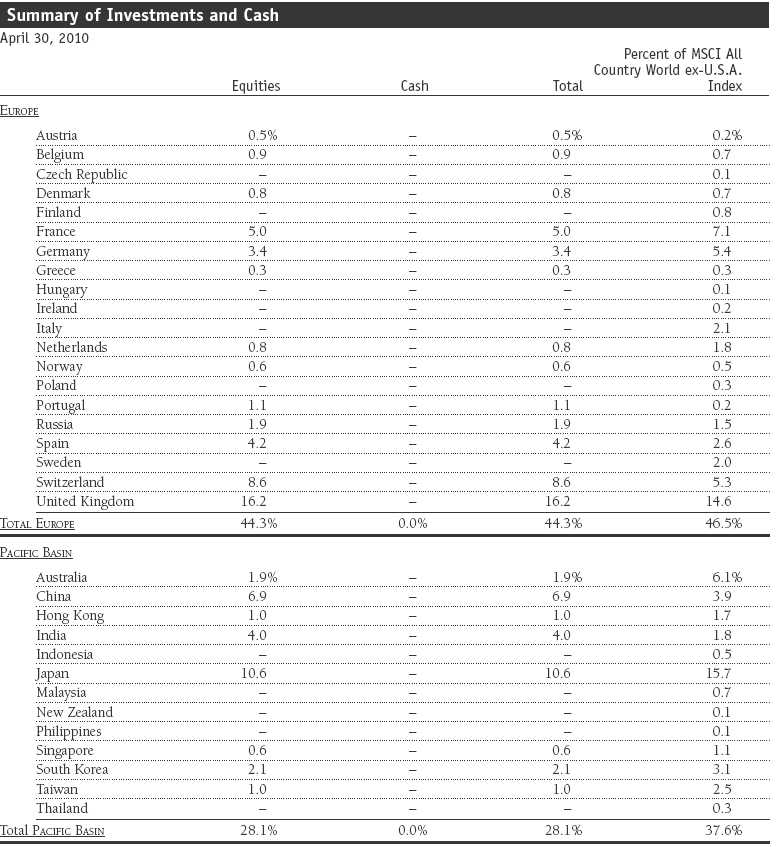
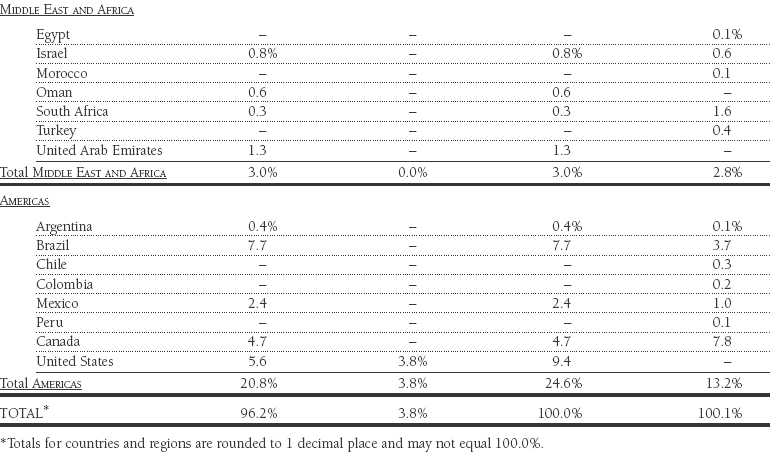
Performance and Expenses
T. Rowe Price Institutional International Growth Equity Fund
| Performance Comparison |
This chart shows the value of a hypothetical $1 million investment in the fund over the past 10 fiscal year periods or since inception (for funds lacking 10-year records). The result is compared with benchmarks, which may include a broad-based market index and a peer group average or index. Market indexes do not include expenses, which are deducted from fund returns as well as mutual fund averages and indexes.
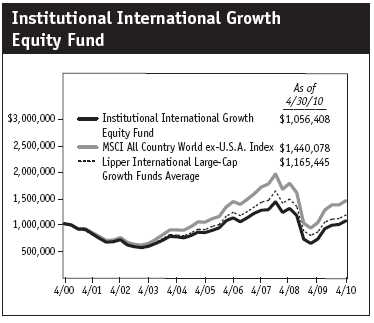
This table shows how the fund would have performed each year if its actual (or cumulative) returns for the periods shown had been earned at a constant rate.
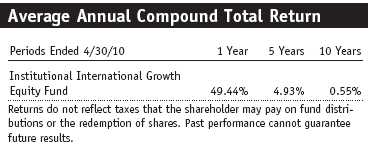
Fund Expense Example
As a mutual fund shareholder, you may incur two types of costs: (1) transaction costs, such as redemption fees or sales loads, and (2) ongoing costs, including management fees, distribution and service (12b-1) fees, and other fund expenses. The following example is intended to help you understand your ongoing costs (in dollars) of investing in the fund and to compare these costs with the ongoing costs of investing in other mutual funds. The example is based on an investment of $1,000 invested at the beginning of the most recent six-month period and held for the entire period.
Actual Expenses
The first line of the following table (“Actual”) provides information about actual account values and actual expenses. You may use the information in this line, together with your account balance, to estimate the expenses that
you paid over the period. Simply divide your account value by $1,000 (for example, an $8,600 account value divided by $1,000 = 8.6), then multiply the result by the number in the first line under the heading “Expenses Paid During
Period” to estimate the expenses you paid on your account during this period.
Hypothetical Example for Comparison Purposes
The information on the second line of the table (“Hypothetical”) is based on hypothetical account values and expenses derived from the fund’s actual expense ratio and an assumed 5% per year rate of return before expenses
(not the fund’s actual return). You may compare the ongoing costs of investing in the fund with other funds by contrasting this 5% hypothetical example and the 5% hypothetical examples that appear in the shareholder reports of the other funds.
The hypothetical account values and expenses may not be used to estimate the actual ending account balance or expenses you paid for the period.
You should also be aware that the expenses shown in the table highlight only your ongoing costs and do not reflect any transaction costs, such as redemption fees or sales loads. Therefore, the second line of the table is useful in
comparing ongoing costs only and will not help you determine the relative total costs of owning different funds. To the extent a fund charges transaction costs, however, the total cost of owning that fund is higher.
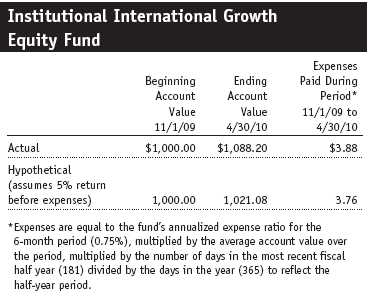
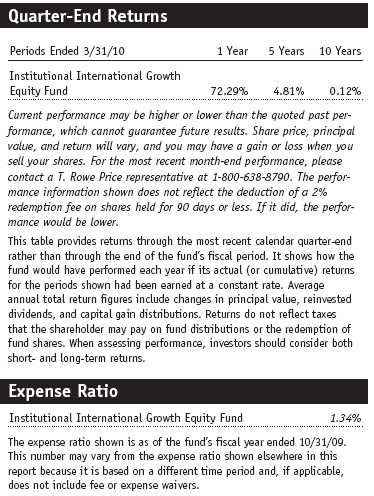
Financial Highlights
T. Rowe Price Institutional International Growth Equity Fund
(Unaudited)
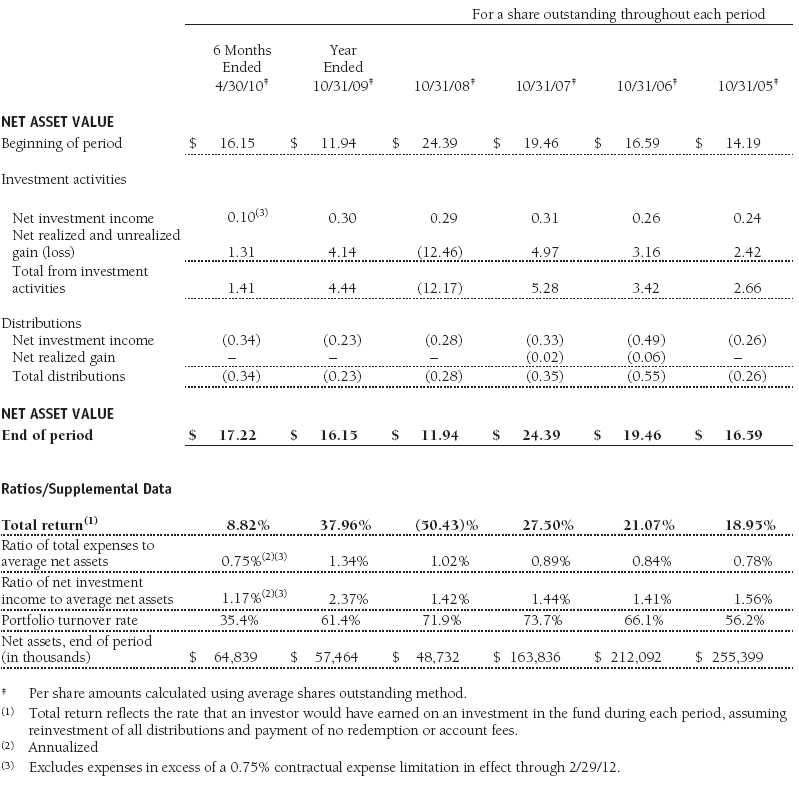
The accompanying notes are an integral part of these financial statements.
Portfolio of Investments‡
T. Rowe Price Institutional International Growth Equity Fund
April 30, 2010 (Unaudited)
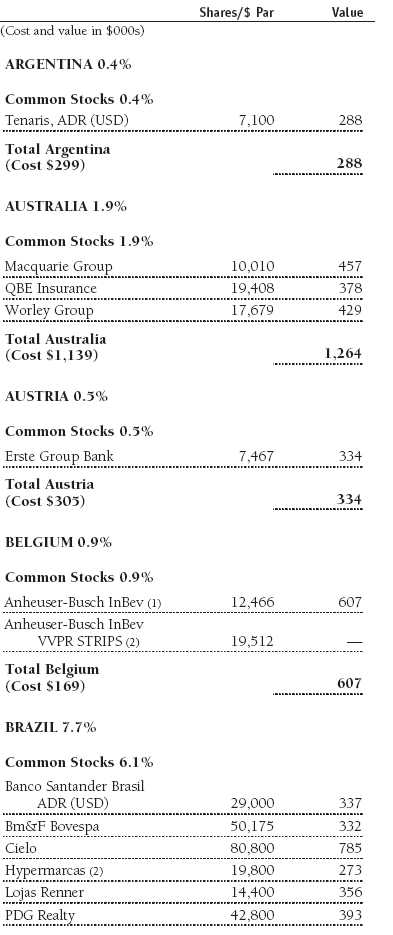
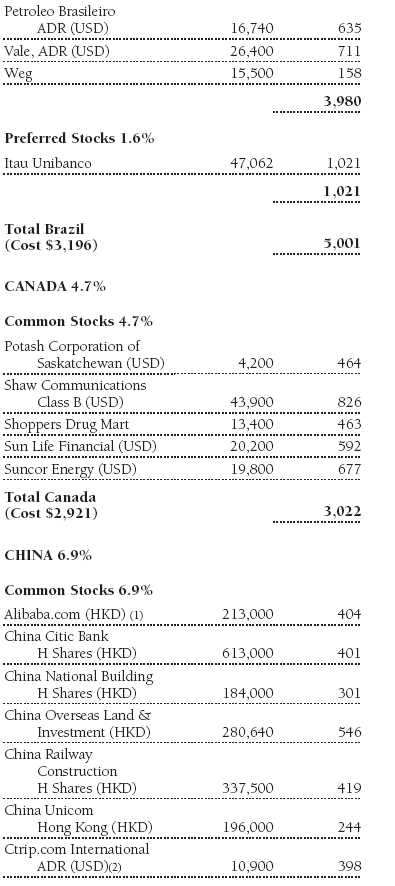
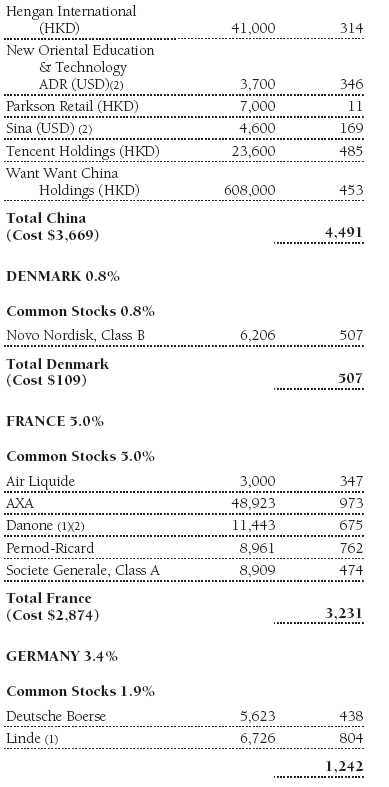
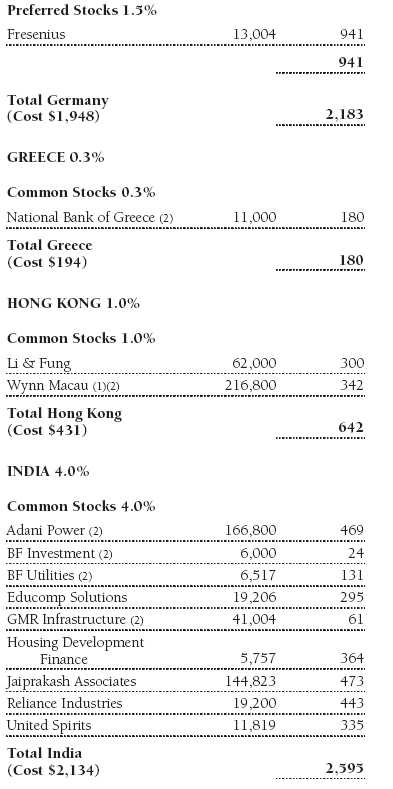
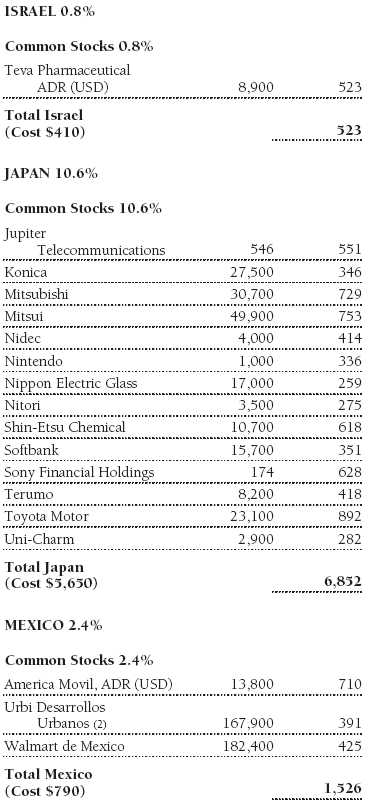
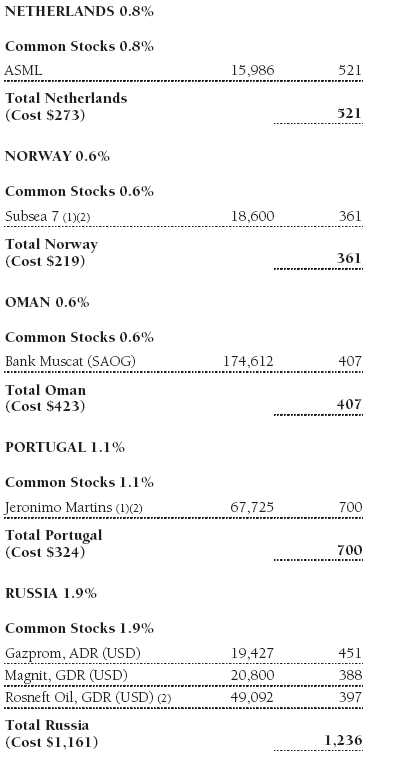
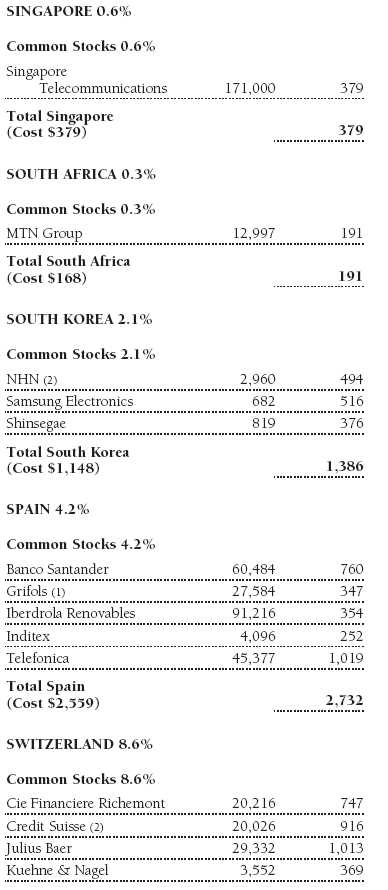
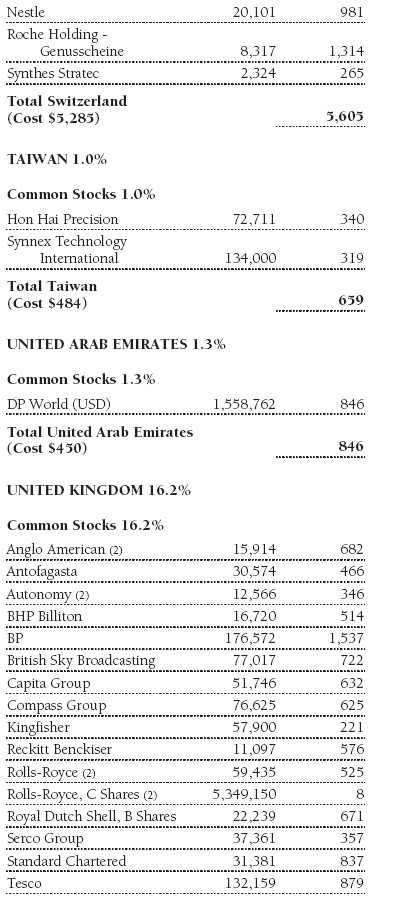
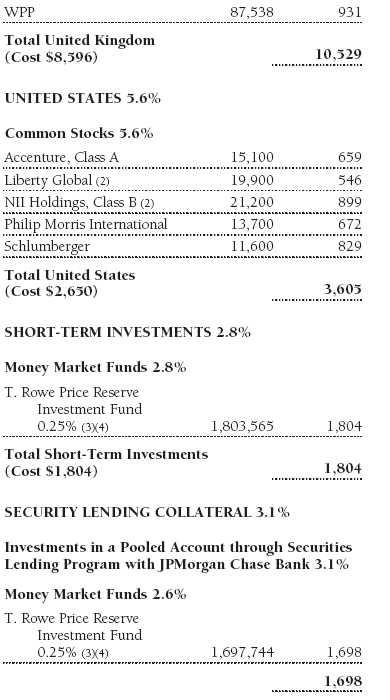
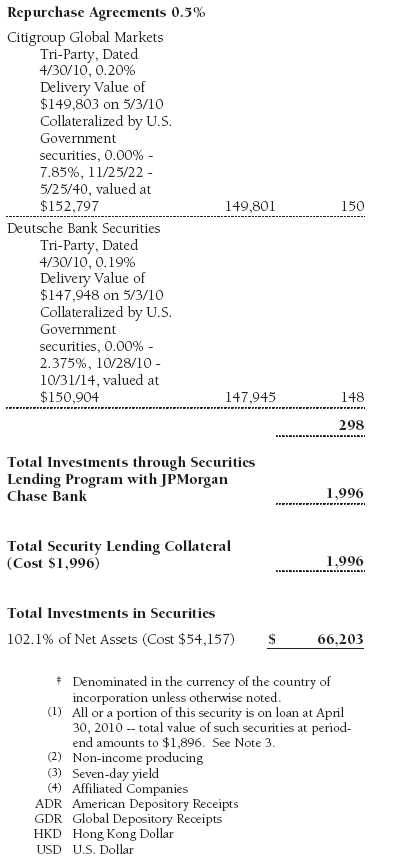
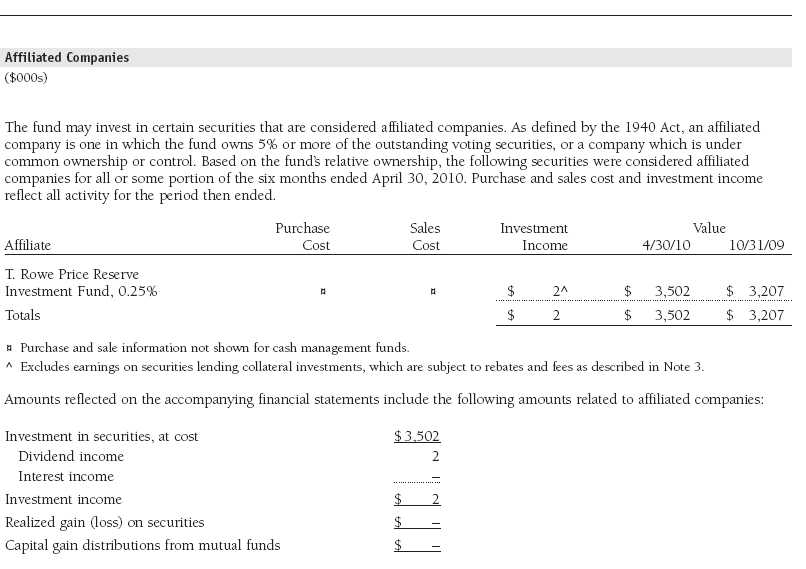
The accompanying notes are an integral part of these financial statements.
Statement of Assets and Liabilities
T. Rowe Price Institutional International Growth Equity Fund
April 30, 2010 (Unaudited)
($000s, except shares and per share amounts)
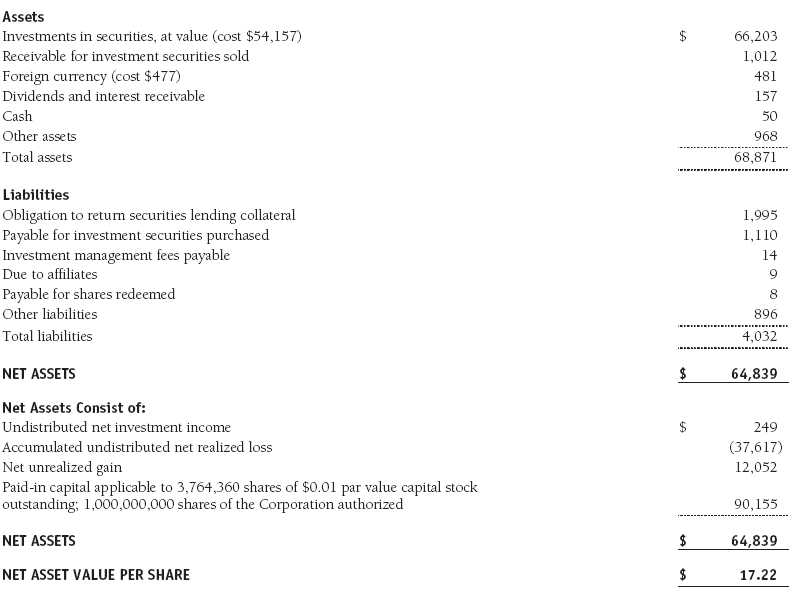
The accompanying notes are an integral part of these financial statements.
Statement of Operations
T. Rowe Price Institutional International Growth Equity Fund
(Unaudited)
($000s)
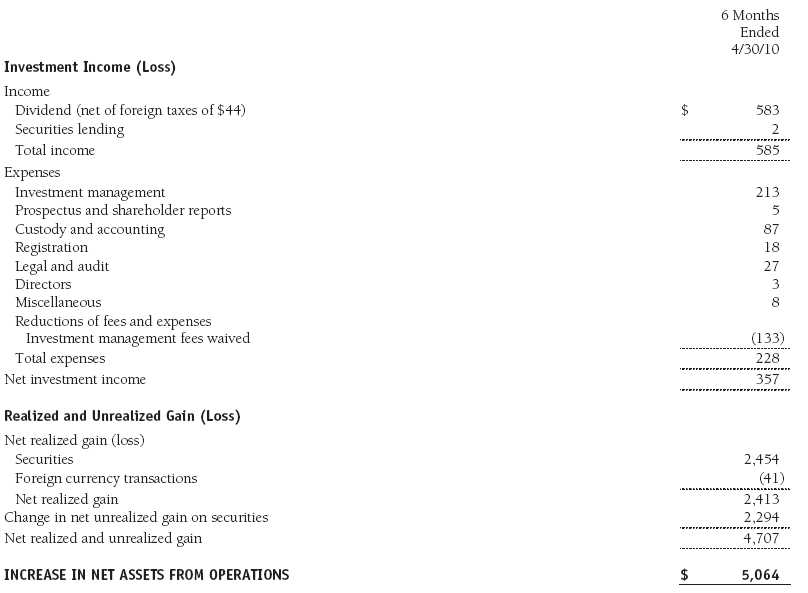
The accompanying notes are an integral part of these financial statements.
Statement of Changes in Net Assets
T. Rowe Price Institutional International Growth Equity Fund
(Unaudited)
($000s)
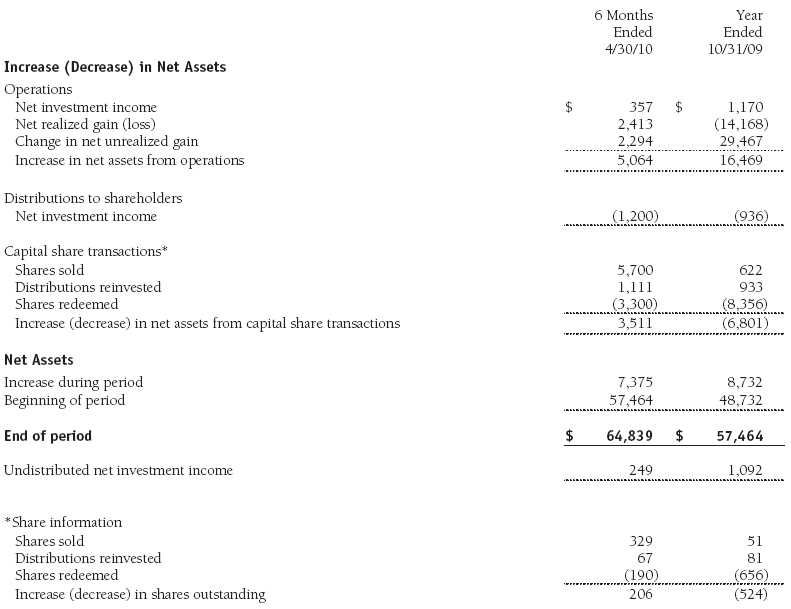
The accompanying notes are an integral part of these financial statements.
Notes to Financial Statements
T. Rowe Price Institutional International Growth Equity Fund
April 30, 2010 (Unaudited)
T. Rowe Price Institutional International Funds, Inc. (the corporation), is registered under the Investment Company Act of 1940 (the 1940 Act). The Institutional International Growth Equity Fund (the fund), a diversified, open-end management investment company, is one portfolio established by the corporation. The fund commenced operations on September 7, 1989. The fund seeks long-term growth of capital through investments primarily in the common stocks of established, non-U.S. companies.
NOTE 1 - SIGNIFICANT ACCOUNTING POLICIES
Basis of Preparation The accompanying financial statements were prepared in accordance with accounting principles generally accepted in the United States of America (GAAP), which require the use of estimates made by fund management. Fund management believes that estimates and security valuations are appropriate; however, actual results may differ from those estimates, and the security valuations reflected in the accompanying financial statements may differ from the value ultimately realized upon sale of the securities.
Investment Transactions, Investment Income, and Distributions Income and expenses are recorded on the accrual basis. Premiums and discounts on debt securities are amortized for financial reporting purposes. Dividends received from mutual fund investments are reflected as dividend income; capital gain distributions are reflected as realized gain/loss. Dividend income and capital gain distributions are recorded on the ex-dividend date. Income tax-related interest and penalties, if incurred, would be recorded as income tax expense. Investment transactions are accounted for on the trade date. Realized gains and losses are reported on the identified cost basis. Distributions to shareholders are recorded on the ex-dividend date. Income distributions are declared and paid annually. Capital gain distributions, if any, are generally declared and paid by the fund, annually.
Currency Translation Assets, including investments, and liabilities denominated in foreign currencies are translated into U.S. dollar values each day at the prevailing exchange rate, using the mean of the bid and asked prices of such currencies against U.S. dollars as quoted by a major bank. Purchases and sales of securities, income, and expenses are translated into U.S. dollars at the prevailing exchange rate on the date of the transaction. The effect of changes in foreign currency exchange rates on realized and unrealized security gains and losses is reflected as a component of security gains and losses.
Redemption Fees A 2% fee is assessed on redemptions of fund shares held for 90 days or less to deter short-term trading and to protect the interests of long-term shareholders. Redemption fees are withheld from proceeds that shareholders receive from the sale or exchange of fund shares. The fees are paid to the fund and are recorded as an increase to paid-in capital. The fees may cause the redemption price per share to differ from the net asset value per share.
New Accounting Pronouncement In January 2010, new accounting guidance was issued that requires enhanced disclosures about fair value measurements in the financial statements; it is effective for fiscal years and interim periods beginning after December 15, 2009. Management expects that adoption of this guidance will have no impact on the fund’s net assets or results of operations.
NOTE 2 - VALUATION
The fund’s investments are reported at fair value as defined under GAAP. The fund determines the values of its assets and liabilities and computes its net asset value per share at the close of the New York Stock Exchange (NYSE), normally 4 p.m. ET, each day that the NYSE is open for business.
Valuation Methods Equity securities listed or regularly traded on a securities exchange or in the over-the-counter (OTC) market are valued at the last quoted sale price or, for certain markets, the official closing price at the time the valuations are made, except for OTC Bulletin Board securities, which are valued at the mean of the latest bid and asked prices. A security that is listed or traded on more than one exchange is valued at the quotation on the exchange determined to be the primary market for such security. Listed securities not traded on a particular day are valued at the mean of the latest bid and asked prices for domestic securities and the last quoted sale price for international securities. Debt securities with remaining maturities of less than one year at the time of acquisition generally use amortized cost in local currency to approximate fair value. However, if amortized cost is deemed not to reflect fair value or the fund holds a significant amount of such securities with remaining maturities of more than 60 days, the securities are valued at prices furnished by dealers who make markets in such securities or by an independent pricing service.
Investments in mutual funds are valued at the mutual fund’s closing net asset value per share on the day of valuation.
Other investments, including restricted securities, and those financial instruments for which the above valuation procedures are inappropriate or are deemed not to reflect fair value are stated at fair value as determined in good faith by the T. Rowe Price Valuation Committee, established by the fund’s Board of Directors.
For valuation purposes, the last quoted prices of non-U.S. equity securities may be adjusted under the circumstances described below. If the fund determines that developments between the close of a foreign market and the close of the NYSE will, in its judgment, materially affect the value of some or all of its portfolio securities, the fund will adjust the previous closing prices to reflect what it believes to be the fair value of the securities as of the close of the NYSE. In deciding whether it is necessary to adjust closing prices to reflect fair value, the fund reviews a variety of factors, including developments in foreign markets, the performance of U.S. securities markets, and the performance of instruments trading in U.S. markets that represent foreign securities and baskets of foreign securities. A fund may also fair value securities in other situations, such as when a particular foreign market is closed but the fund is open. The fund uses outside pricing services to provide it with closing prices and information to evaluate and/or adjust those prices. The fund cannot predict how often it will use closing prices and how often it will determine it necessary to adjust those prices to reflect fair value. As a means of evaluating its security valuation process, the fund routinely compares closing prices, the next day’s opening prices in the same markets, and adjusted prices.
Valuation Inputs Various inputs are used to determine the value of the fund’s financial instruments. These inputs are summarized in the three broad levels listed below:
Level 1 – quoted prices in active markets for identical securities
Level 2 – observable inputs other than Level 1 quoted prices (including, but not limited to, quoted prices for similar securities, interest rates, prepayment speeds, and credit risk)
Level 3 – unobservable inputs
Observable inputs are those based on market data obtained from sources independent of the fund, and unobservable inputs reflect the fund’s own assumptions based on the best information available. The input levels are not necessarily an indication of the risk or liquidity associated with financial instruments at that level. For example, non-U.S. equity securities actively traded in foreign markets generally are reflected in Level 2 despite the availability of closing prices because the fund evaluates and determines whether those closing prices reflect fair value at the close of the NYSE or require adjustment, as described above. The following table summarizes the fund’s financial instruments, based on the inputs used to determine their values on April 30, 2010:
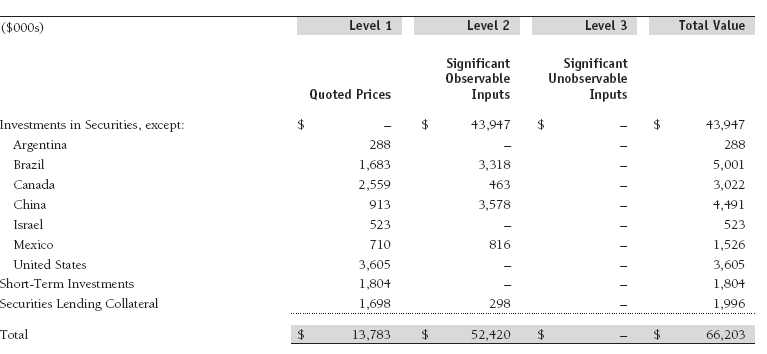
NOTE 3 - OTHER INVESTMENT TRANSACTIONS
Consistent with its investment objective, the fund engages in the following practices to manage exposure to certain risks and/or to enhance performance. The investment objective, policies, program, and risk factors of the fund are described more fully in the fund’s prospectus and Statement of Additional Information.
Emerging Markets At April 30, 2010, approximately 30% of the fund’s net assets were invested, either directly or indirectly, in securities of companies located in emerging markets, securities issued by governments of emerging market countries, and/or securities denominated in or linked to the currencies of emerging market countries. Emerging market securities are often subject to greater price volatility, less liquidity, and higher rates of inflation than U.S. securities. In addition, emerging markets may be subject to greater political, economic and social uncertainty, and differing regulatory environments that may potentially impact the fund’s ability to buy or sell certain securities or repatriate proceeds to U.S. dollars.
Repurchase Agreements All repurchase agreements are fully collateralized by U.S. government securities. Collateral is in the possession of the fund’s custodian or, for tri-party agreements, the custodian designated by the agreement. Collateral is evaluated daily to ensure that its market value exceeds the delivery value of the repurchase agreements at maturity. Although risk is mitigated by the collateral, the fund could experience a delay in recovering its value and a possible loss of income or value if the counterparty fails to perform in accordance with the terms of the agreement.
Securities Lending The fund lends its securities to approved brokers to earn additional income. It receives as collateral cash and U.S. government securities valued at 102% to 105% of the value of the securities on loan. Cash collateral is invested by the fund’s lending agent(s) in accordance with investment guidelines approved by fund management. Although risk is mitigated by the collateral, the fund could experience a delay in recovering its securities and a possible loss of income or value if the borrower fails to return the securities or if collateral investments decline in value. Securities lending revenue recognized by the fund consists of earnings on invested collateral and borrowing fees, net of any rebates to the borrower and compensation to the lending agent. On April 30, 2010, the value of loaned securities was $1,896,000.
Other Purchases and sales of portfolio securities other than short-term securities aggregated $22,989,000 and $20,910,000, respectively, for the six months ended April 30, 2010.
NOTE 4 - FEDERAL INCOME TAXES
No provision for federal income taxes is required since the fund intends to continue to qualify as a regulated investment company under Subchapter M of the Internal Revenue Code and distribute to shareholders all of its taxable income and gains. Distributions determined in accordance with federal income tax regulations may differ in amount or character from net investment income and realized gains for financial reporting purposes. Financial reporting records are adjusted for permanent book/tax differences to reflect tax character but are not adjusted for temporary differences. The amount and character of tax-basis distributions and composition of net assets are finalized at fiscal year-end; accordingly, tax-basis balances have not been determined as of the date of this report.
The fund intends to retain realized gains to the extent of available capital loss carryforwards. As of October 31, 2009, the fund had $38,574,000 of unused capital loss carryforwards, which expire: $24,695,000 in fiscal 2011 and $13,879,000 in fiscal 2017. Additionally, approximately $15,309,000 of the fund’s unused capital loss carryforwards are subject to certain limitations on amount and/or timing of use related to an ownership change.
At April 30, 2010, the cost of investments for federal income tax purposes was $54,157,000. Net unrealized gain aggregated $12,052,000 at period-end, of which $13,849,000 related to appreciated investments and $1,797,000 related to depreciated investments.
NOTE 5 - FOREIGN TAXES
The fund is subject to foreign income taxes imposed by certain countries in which it invests. Acquisition of certain foreign currencies related to security transactions are also subject to tax. Additionally, capital gains realized by the fund upon disposition of securities issued in or by certain foreign countries are subject to capital gains tax imposed by those countries. All taxes are computed in accordance with the applicable foreign tax law, and, to the extent permitted, capital losses are used to offset capital gains. Tax expense attributable to income is accrued by the fund as a reduction of income. Taxes incurred on the purchase of foreign currencies are recorded as realized loss on foreign currency transactions. Current and deferred tax expense attributable to net capital gains is reflected as a component of realized and/or change in unrealized gain/loss on securities in the accompanying financial statements. At April 30, 2010, the fund had no deferred tax liability attributable to foreign securities and $7,217,000 of foreign capital loss carryforwards, including $3,504,000 that expire in 2011, $3,312,000 that expire in 2012, $37,000 that expire in 2013, $33,000 that expire in 2016 and $331,000 that expire in 2017.
NOTE 6 - RELATED PARTY TRANSACTIONS
The fund is managed by T. Rowe Price International, Inc. (the manager), a wholly owned subsidiary of T. Rowe Price Associates, Inc. (Price Associates), which is wholly owned by T. Rowe Price Group, Inc. The investment management agreement between the fund and the manager provides for an annual investment management fee equal to 70% of the fund’s average daily net assets. The fee is computed daily and paid monthly.
The fund is also subject to a contractual expense limitation through February 29, 2012. During the limitation period, the manager is required to waive its management fee and reimburse the fund for any expenses, excluding interest, taxes, brokerage commissions, and extraordinary expenses, that would otherwise cause the fund’s ratio of annualized total expenses to average net assets (expense ratio) to exceed its expense limitation of 0.75%. The fund is required to repay the manager for expenses previously reimbursed and management fees waived to the extent the fund’s net assets have grown or expenses have declined sufficiently to allow repayment without causing the fund’s expense ratio to exceed its expense limitation. However, no repayment will be made more than three years after the date of any reimbursement or waiver or later than February 28, 2014. Pursuant to this agreement, management fees in the amount of $133,000 were waived during the six months ended April 30, 2010. Including these amounts, management fees waived in the amount of $133,000 remain subject to repayment by the fund at April 30, 2010.
In addition, the fund has entered into service agreements with Price Associates and a wholly owned subsidiary of Price Associates (collectively, Price). Price Associates computes the daily share price and provides certain other administrative services to the fund. T. Rowe Price Services, Inc., provides shareholder and administrative services in its capacity as the fund’s transfer and dividend disbursing agent. For the six months ended April 30, 2010, expenses incurred pursuant to these service agreements were $55,000 for Price Associates and less than $1,000 for T. Rowe Price Services, Inc. The total amount payable at period-end pursuant to these service agreements is reflected as Due to Affiliates in the accompanying financial statements.
The fund may invest in the T. Rowe Price Reserve Investment Fund and the T. Rowe Price Government Reserve Investment Fund (collectively, the T. Rowe Price Reserve Investment Funds), open-end management investment companies managed by Price Associates and considered affiliates of the fund. The T. Rowe Price Reserve Investment Funds are offered as cash management options to mutual funds, trusts, and other accounts managed by Price Associates and/or its affiliates and are not available for direct purchase by members of the public. The T. Rowe Price Reserve Investment Funds pay no investment management fees.
NOTE 7 - SUBSEQUENT EVENT
Effective June 1, 2010, the T. Rowe Price Institutional Foreign Equity Fund was renamed the T. Rowe Price Institutional International Growth Equity Fund.
| Information on Proxy Voting Policies, Procedures, and Records |
A description of the policies and procedures used by T. Rowe Price funds and portfolios to determine how to vote proxies relating to portfolio securities is available in each fund’s Statement of Additional Information, which you may request by calling 1-800-225-5132 or by accessing the SEC’s Web site, www.sec.gov. The description of our proxy voting policies and procedures is also available on our Web site, www.troweprice.com. To access it, click on the words “Our Company” at the top of our corporate homepage. Then, when the next page appears, click on the words “Proxy Voting Policies” on the left side of the page.
Each fund’s most recent annual proxy voting record is available on our Web site and through the SEC’s Web site. To access it through our Web site, follow the directions above, then click on the words “Proxy Voting
Records” on the right side of the Proxy Voting Policies page.
| How to Obtain Quarterly Portfolio Holdings |
The fund files a complete schedule of portfolio holdings with the Securities and Exchange Commission for the first and third quarters of each fiscal year on Form N-Q. The fund’s Form N-Q is available electronically on the
SEC’s Web site (www.sec.gov); hard copies may be reviewed and copied at the SEC’s Public Reference Room, 450 Fifth St. N.W., Washington, DC 20549. For more information on the Public Reference Room, call 1-800-SEC-0330.
| Approval of Investment Management Agreement |
On March 9, 2010, the fund’s Board of Directors (Board) unanimously approved the continuation of the investment advisory contract (Contract) between the fund and its investment manager, T. Rowe Price International, Inc. (Adviser), and the investment subadvisory contract (Subadvisory Contract) between the Adviser and T. Rowe Price Global Investment Services Limited (Subadviser). The Board considered a variety of factors in connection with its review of the Contract and Subadvisory Contract, also taking into account information provided by the Adviser during the course of the year, as discussed below:
Services Provided by the Adviser
The Board considered the nature, quality, and extent of the services provided to the fund by the Adviser and Subadviser. These services included, but were not limited to, management of the fund’s portfolio and a variety of related
activities, as well as financial and administrative services, reporting, and communications. The Board also reviewed the background and experience of the Adviser’s senior management team and investment personnel involved in the management of
the fund. The Board concluded that it was satisfied with the nature, quality, and extent of the services provided by the Adviser and Subadviser.
Investment Performance of the Fund
The Board reviewed the fund’s average annual total returns over the 1-, 3-, 5-, and 10-year periods, as well as the fund’s year-by-year returns, and compared these returns with a wide variety of previously agreed upon
comparable performance measures and market data, including those supplied by Lipper and Morningstar, which are independent providers of mutual fund data. On the basis of this evaluation and the Board’s ongoing review of investment results, and
factoring in the severity of the market turmoil during 2008 and 2009, the Board concluded that the fund’s performance was satisfactory.
Costs, Benefits, Profits, and Economies of Scale
The Board reviewed detailed information regarding the revenues received by the Adviser under the Contract and other benefits that the Adviser (and its affiliates, including the Subadviser) may have realized from its relationship with
the fund, including research received under “soft dollar” agreements and commission-sharing arrangements with broker-dealers. The Board considered that the Adviser may receive some benefit from its soft-dollar arrangements pursuant to
which it receives research from broker-dealers that execute the applicable fund’s portfolio transactions. The Board did not review information regarding profits realized from managing the fund in particular because the fund had not achieved
sufficient scale in terms of portfolio asset size to produce meaningful profit margin percentages. The Board concluded that the Adviser’s profits from advising T. Rowe Price mutual funds were reasonable in light of the services provided to the
fund. The Board also considered whether the fund or other funds benefit under the fee levels set forth in the Contract from any economies of scale realized by the Adviser. The Board concluded that the advisory fee structure for the fund continued to
provide for a reasonable sharing of benefits from any economies of scale with the fund’s investors.
Fees
The Board reviewed the fund’s management fee rate, operating expenses, and total expense ratio and compared them with fees and expenses of other comparable funds based on information and data supplied by Lipper. The information
provided to the Board indicated that the fund’s management fee rate was generally below the median for comparable funds and the fund’s total expense ratio was above the median for comparable funds. The Board also reviewed the fee schedules
for institutional accounts of the Adviser and its affiliates with smaller mandates. Management informed the Board that the Adviser’s responsibilities for institutional accounts are more limited than its responsibilities for the fund and other
T. Rowe Price mutual funds that it or its affiliates advise and that the Adviser performs significant additional services and assumes greater risk for the fund and other T. Rowe Price mutual funds that it advises than it does for institutional
accounts. On the basis of the information provided, the Board concluded that the fees paid by the fund under the Contract were reasonable.
Approval of the Contract and Subadvisory Contract
As noted, the Board approved the continuation of the Contract and Subadvisory Contract. No single factor was considered in isolation or to be determinative to the decisions. Rather, the Board was assisted by the advice of independent
legal counsel and concluded, in light of a weighting and balancing of all factors considered, that it was in the best interests of the fund to approve the continuation of the Contract and the Subadvisory Contract, including the fees to be charged
for services thereunder.
Item 2. Code of Ethics.
A code of ethics, as defined in Item 2 of Form N-CSR, applicable to its principal executive officer, principal financial officer, principal accounting officer or controller, or persons performing similar functions is filed as an exhibit to the registrant’s annual Form N-CSR. No substantive amendments were approved or waivers were granted to this code of ethics during the registrant’s most recent fiscal half-year.
Item 3. Audit Committee Financial Expert.
Disclosure required in registrant’s annual Form N-CSR.
Item 4. Principal Accountant Fees and Services.
Disclosure required in registrant’s annual Form N-CSR.
Item 5. Audit Committee of Listed Registrants.
Not applicable.
Item 6. Investments.
(a) Not applicable. The complete schedule of investments is included in Item 1 of this Form N-CSR.
(b) Not applicable.
Item 7. Disclosure of Proxy Voting Policies and Procedures for Closed-End Management Investment Companies.
Not applicable.
Item 8. Portfolio Managers of Closed-End Management Investment Companies.
Not applicable.
Item 9. Purchases of Equity Securities by Closed-End Management Investment Company and Affiliated Purchasers.
Not applicable.
Item 10. Submission of Matters to a Vote of Security Holders.
Not applicable.
Item 11. Controls and Procedures.
(a) The registrant’s principal executive officer and principal financial officer have evaluated the registrant’s disclosure controls and procedures within 90 days of this filing and have concluded that the registrant’s disclosure controls and procedures were effective, as of that date, in ensuring that information required to be disclosed by the registrant in this Form N-CSR was recorded, processed, summarized, and reported timely.
(b) The registrant’s principal executive officer and principal financial officer are aware of no change in the registrant’s internal control over financial reporting that occurred during the registrant’s second fiscal quarter covered by this report that has materially affected, or is reasonably likely to materially affect, the registrant’s internal control over financial reporting.
Item 12. Exhibits.
(a)(1) The registrant’s code of ethics pursuant to Item 2 of Form N-CSR is filed with the registrant’s annual Form N-CSR.
(2) Separate certifications by the registrant's principal executive officer and principal financial officer, pursuant to Section 302 of the Sarbanes-Oxley Act of 2002 and required by Rule 30a-2(a) under the Investment Company Act of 1940, are attached.
(3) Written solicitation to repurchase securities issued by closed-end companies: not applicable.
(b) A certification by the registrant's principal executive officer and principal financial officer, pursuant to Section 906 of the Sarbanes-Oxley Act of 2002 and required by Rule 30a-2(b) under the Investment Company Act of 1940, is attached.
SIGNATURES |
|
| Pursuant to the requirements of the Securities Exchange Act of 1934 and the Investment | |
| Company Act of 1940, the registrant has duly caused this report to be signed on its behalf by the | |
| undersigned, thereunto duly authorized. | |
| T. Rowe Price Institutional International Funds, Inc. | |
| By | /s/ Edward C. Bernard |
| Edward C. Bernard | |
| Principal Executive Officer | |
| Date | June 17, 2010 |
| Pursuant to the requirements of the Securities Exchange Act of 1934 and the Investment | |
| Company Act of 1940, this report has been signed below by the following persons on behalf of | |
| the registrant and in the capacities and on the dates indicated. | |
| By | /s/ Edward C. Bernard |
| Edward C. Bernard | |
| Principal Executive Officer | |
| Date | June 17, 2010 |
| By | /s/ Gregory K. Hinkle |
| Gregory K. Hinkle | |
| Principal Financial Officer | |
| Date | June 17, 2010 |